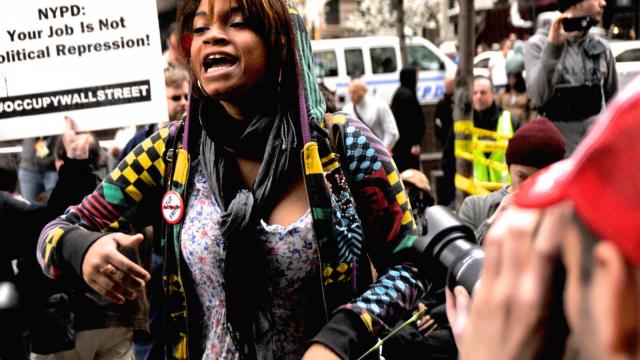
Last week, Sen. Elizabeth Warren (D-MA) introduced a bill addressing two of her top legislative priorities: The crushing burden of student debt and tax loopholes that allow the wealthiest Americans to shell out a smaller share of their incomes than do many of those in the middle class.
The measure would allow people who took out student loans at a higher rate than they could get today to refinance their debt the same way one might refinance a home mortgage. It would also give people with high-interest private loans to roll them over into the Federal Direct Loan program.
The measure would cut into the government’s revenues, and Warren would make up that shortfall by implementing the “Buffett Rule,” which would raise taxes on those making $1 million or more in income.
The bill is part of a campaign called Higher Ed, Not Debt, which Warren helped launch in March. It’s being waged by a broad coalition of unions and progressive groups including the Working Families Party, Progress Now and Jobs for Justice and a couple of think tanks, the Center for American Progress and Demos.
The campaign has broad goals, including highlighting the role Wall Street has played in financializing student debt products. But Nelini Stamp, youth outreach director for Working Families, tells BillMoyers.com that it is part of a larger battle over education in America from pre-kindergarten up. Below is a lightly edited transcript of our discussion.
Joshua Holland: Tell us about this new campaign.
Nelini Stamp: Last week, groups gathered in Washington, DC, and across the country — more than 10 actions in 10 states — to launch the Higher Ed Not Debt campaign. Working Families is one of dozens of groups involved — it includes national and state-based youth groups, labor organizations and grassroots groups that are trying to tackle the student debt crisis and make higher education affordable.
This campaign has a special message to me, because I was never able to go to college. I didn’t go because when my mother and I applied, we found out that financial aid applications didn’t recognize my mom’s same-sex partner. And I would have been a first generation college student, and we didn’t really know how to navigate loans. So this is something that affected me eight years ago and is still affecting people with the increasingly high burden of student loan debt.
JH: What are you looking to accomplish, legislatively or otherwise?
NS: The Higher Ed Not Debt Campaign has a couple of goals, and one is to tackle the existing $1.2 trillion of debt held by 40 million Americans and to provide relief — a lot of people don’t know there are relief options out there, like income-based repayment, or pay-as-you-earn.
We want to make quality higher education more affordable, as well as accessible, because we believe that higher education is a public good and no one should have to struggle under the financial burden of going to college. And we are working to combat the privatization of higher education and confront the role of Wall Street in the compounding student debt crisis.
Finally, we want to spark a conversation around civic engagement and political participation among young people, as well as older people. I believe around 30 percent of student loan debt is held by people who are over the age of 30.
JH: Let’s get beyond numbers. How is this issue affecting people who are trying to enter the workforce?
NS: The problem is multifaceted. Look at buying a house or a car. Student loan debt is affecting those sales, because if you’re still trying to pay off a loan or two, how are you going to pay for a home? How are you able to own a car to get you to work?
Because of the job market a lot of young people who graduate out of college are finding themselves in low-wage work, or finding themselves in unpaid internships, and are not able to pay back those loans. And when people take out private student loans — there are private and federal student loans — private student loan interest rates can be anywhere from 9-12 percent. That adds up to significant money that could be used for saving up to buy a house or a car, or for rent — it could be used for so many other things that could put those dollars back into the economy. Instead, we’re paying off debt.
And right now, as we speak, at least seven million out of the 40 million borrowers in the US are in default [on their student loans].
JH: Several factors contribute to the rise in tuition costs, but the leading factor is cuts to education spending in state budgets. We finance higher education through a blend of tuition and federal and state money. It’s easy to sell people on cutting their taxes — everybody wants a tax cut, but then you have to understand that there’s a price to be paid, and it’s being paid by young people coming out of college with this mountain of debt.
The Oregon Working Families Party is pushing a bill called Pay It Forward. It’s being considered in several states. Can you tell us a little bit about that?
NS: At Working Families, we are doing our best to elevate innovative policies at the state level. And in Oregon, students at Portland State University, with guidance from a couple of professors — Barbara Dudley and Mary King — were looking across the country for solutions and found Pay It Forward. Those students decided to lobby their legislators, and last July Oregon passed Pay It Forward unanimously in the state legislature.
Pay It Forward allows students to go to college tuition-free — you pay no tuition up front. And then you pay a certain percentage of your income every year after you graduate for a certain amount of years. This removes the barrier of access, and instead of paying to the Wall Street banks, you’re paying to the state.
And it sparked similar proposals in more than 15 states across the country.
JH: Some have criticized this idea as being too modest given the scale of the problem, in part because it would take several years to get enough funding into the system to have it be self-supporting. Another criticism is that Pay It Forward is a retreat from something more ambitious like full public funding of higher education. How do you respond?
NS: For years, we’ve been fighting for more funding for higher education and we’ve been getting cutbacks and more cutbacks. In 2010, Oregon cut financial aid by 75 percent. So students in Oregon are in a dire position. Pay It Forward is not necessarily the way to go for every state, but we believe that in states that continue to cut back, we need a forward-looking solution. We can’t just continue to fight against cuts or to fight for tuition freezes. We need to fight for a bold vision — like debt-free higher education. Free higher education is a goal for us and for many of our allies. But I think right now, we saw a way to implement a program that has gotten other states to think about what a world with debt-free higher education would look like. Because right now, we’re just continuing to get cuts every year on the state and local level.
That’s why we decided to move forward with Pay It Forward. And, again, we’re looking at a lot of different options here. We also know that we need to help borrowers who are now paying back $1.2 trillion in loans. So Pay It Forward is just one step and it allows us to think about a debt-free future.
JH: Let me shift gears. You spoke about the privatization of education. Working Families is very engaged in New York. Can you give us some insight into this battle between the de Blasio administration and Eva Moskowitz? Who is Eva Moskowitz?
NS: Eva Moskowitz has been a big proponent of charter schools. She was a former city council member who now runs the Success Academy Charter Schools. And recently, she has been caught in this battle with Bill de Blasio over the co-location of charter and public schools. De Blasio allowed most of her co-location schools to be approved, except for three.
Recently, while de Blasio was having a rally for universal pre-k, which Eva Moskowitz had said she supported before, Moskowitz decided to do a pro-charter school rally, and she closed down her 22 schools and turned her kids into political props for a rally. Imagine if public schools did that — if we shut down all public schools so they could just lobby for universal pre-k? It would be an outrage. But charters are public in that they’re funded by public tax dollars.
JH: The fight over charter schools seems to be one that doesn’t always fall along the usual political lines. Many African-Americans are in favor of charters. Does that make it more difficult for progressives to tackle this issue?
NS: There’s a reason for that. Just like we’ve been doing in higher education, we’ve been privatizing public schools and we’ve been cutting teachers, teacher salaries. So it’s understandable, because a lot of African-Americans live in lower income neighborhoods and they’re the ones that are targeted by charter schools. And they are seen by many as a solution and an alternative.
I do believe that it makes it a little bit difficult, but I think the bottom line here is that we need to show that we’re fighting for something like free universal pre-k, something that will help everyone, low-income parents, African-American families — we need to fight for that.
JH: Where does the campaign go next, and how can people get involved?
NS: People can get involved by visiting Higher Ed, Not Debt website, the Working Families website, as well as visiting UPKNY.org. And people should sign petitions, come to rallies, write letters to the governor and support Mayor de Blasio as he fights for free universal pre-k.
3 WAYS TO SHOW YOUR SUPPORT
- Log in to post comments












